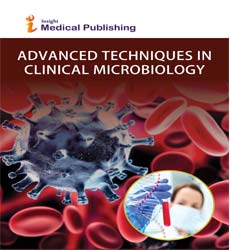A Prospective Study Found That Treating Mildly to Moderately Photoaged Skin with Topical Tretinoin Has a Positive Psychosocial Effect
Ed J. Kuijper*
Department of Medical Microbiology, Leiden University of Medical Center, Netherlands.
- Corresponding Author:
- Ed J. Kuijper
Department of Medical Microbiology
Leiden University of Medical Center, Netherlands
E-mail: Kuijper@EdJ.nlr
Received Date: December 03, 2021; Accepted Date: December 17, 2021; Published Date: December 24, 2021
Citation: Ed J. Kuijper (2021) A Prospective Study Found That Treating Mildly to Moderately Photoaged Skin with Topical Tretinoin Has a Positive Psychosocial Effect. Adv Tech Clin Microbiol. Vol.3 No.3:112
Copyright: © 2021 Ed J. Kuijper. This is an open-access article distributed under the terms of the Creative Commons Attribution License, which permits unrestricted use, distribution, and reproduction in any medium, provided the original author and source are credited.
Introduction
In a randomised, double-blind, vehicle-controlled, multicenter research, the clinical and histologic effects of a new emollient cream formulation of topical tretinoin at doses of 0.05% and 0.01% were investigated in 251 patients with mild to moderate photodamaged facial skin. Seventy-nine% of patients who received 0.05% terinoic for 24 weeks demonstrated overall improvement in photodamaged skin, compared to 48% of control subjects who received vehicle. When 0.05% retinoic therapy was compared to controls, fine wrinkling, patchy hyperpigmentation, roughness, and laxity all decreased significantly. In addition, histopathological alterations such as increased epidermal thickness, decreased melanin concentration, and stratum corneum compaction suggest clinical improvement. Erythema, peeling, and stinging were all common side effects that were often minor and well tolerated.
Tretinoin, applied topically at a concentration of 0.1%, has been proven to reduce wrinkles and uneven pigmentation in photoaged skin. The goal of this trial was to see if different amounts of tretinoin in a novel emollient cream base were safe and effective in treating photo aged skin [1].
In a 24-week, double-blind, randomised, multicenter study of 296 patients with photodamaged face skin, three concentrations of tretinoin (0.05%, 0.01%, and 0.001%) in a novel emollient cream formulation were compared to vehicle [2].
Tretinoin emollient cream 0.05% produced a considerably superior overall response to therapy than vehicle (p less than 0.001), with 68% of individuals showing improvement at the end of treatment compared to 43% in the vehicle group. In comparison to 11% of participants treated with vehicle, 26% of those treated with tretinoin emollient cream 0.05% had an excellent or good response. Subjects who got tretinoin emollient cream 0.05% had less fine wrinkling, mottled hyperpigmentation, and roughness than those who received vehicle (p less than 0.05). There was no discernible difference between the vehicle and the tretinoin emollient cream 0.01% or 0.001%.
After treatment with tretinoin emollient cream 0.05% or 0.01%, histologic analysis revealed increased epidermal and granular layer thickness, decreased melanin content, and stratum corneum compaction. The most common side effects were mild to moderate skin responses such as erythema, peeling, and burning, which, while more common in the 0.05% concentration group, did not limit retinoid use [3].
Skin thinning caused by long-term corticosteroid use is a big problem. Finding a medication that avoids skin shrinkage caused by corticosteroid therapy while also not interfering with the anti-inflammatory activity of the corticosteroid is a significant benefit. In this study, negative effects from vitiligo treatment with topical corticosteroid were considerably reduced in patients who also utilised topical retinoid. The beneficial effect of topical mometasone furoate 0.1% and topical tretinoin 0.05% on regimentation in patients with vitiligo was also a key finding in this study [4]. In four patients (25%) after three months and six patients (37.5%) after six months, utilising topical mometasone furoate 0.1% and topical tretinoin 0.05% to reduce the unfavourable effects of long-term topical corticosteroid treatment increased the therapeutic impact on vitiligo.Furthermore, topical mometasone furoate 0.1% + topical tretinoin 0.05% caused repigmentation within 6 months. Another benefit of this treatment is the speed with which it works.
References
- Goldfarb MT, Ellis CN, Voorhees JJ (1990) Topical tretinoin: its use in daily practice to reverse photoageing. Br J Dermatol35: 87 -91.
- Gilchrest BA (1992) Retinoids and photodamage. Br J Dermatol 41: 14 -20.
- Xu AE, Zhang DM, Wei XD, Huang B, Lu LJ (2009) Efficacy and safety of tarcrolimus cream 0.1% in the treatment of vitiligo. Int JDermatol 48: 86 -90.
- Griffiths CE, Russman AN, Majmudar G, Singer RS, Hamilton TA, et al. (1993) Restoration of collagen formation in photodamaged human skin by tretinoin (retinoic acid). N Engl J Me 329: 530 -5.
Open Access Journals
- Aquaculture & Veterinary Science
- Chemistry & Chemical Sciences
- Clinical Sciences
- Engineering
- General Science
- Genetics & Molecular Biology
- Health Care & Nursing
- Immunology & Microbiology
- Materials Science
- Mathematics & Physics
- Medical Sciences
- Neurology & Psychiatry
- Oncology & Cancer Science
- Pharmaceutical Sciences
